#15th c. Germany
Text

Reliquary bust of St. Mary Magdalene by Michel Erhart, c. 1475-80
#michel erhart#german style#germany#15th c. Germany#15th century#bust#religious art#mdpsculpture#sculpture#15th c. sculpture#1470s#medieval#gothic#headdress
739 notes
·
View notes
Text
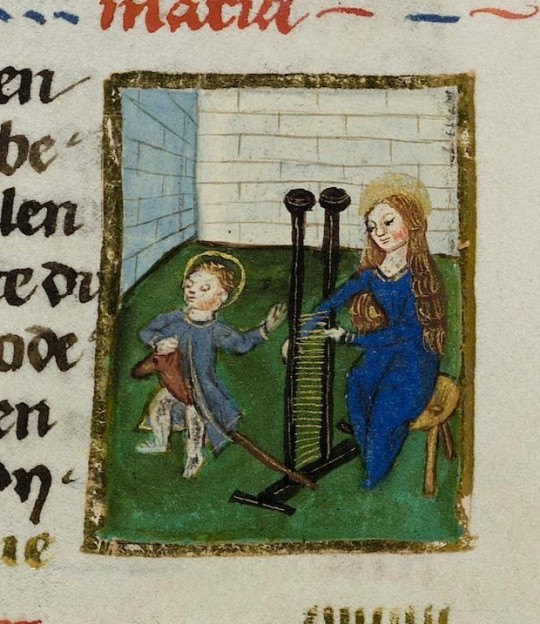
mary and the child jesus
in a book of prayers ("liber precum"), northern germany, 15th c.
source: Heidelberg, UB, Cod. Trübner 148, fol. 54v
206 notes
·
View notes
Photo

History & Mining Culture of the Ore Mountains
The Ore Mountains (Erzgebirge) on the border between Germany and the Czech Republic is a region rich in history and culture connected to the mining industry. For centuries the cities on both sides of the mountain range had sustained themselves and flourished by the extraction of tin, copper, zinc, uranium, and most importantly silver. Even though the mines are now closed the mining culture and heritage is still widely celebrated and visible for visitors, with the hammer and chisel motif on many buildings in the different mining towns.
The rich mining heritage of the region was recently inscribed on the UNESCO world heritage list (July 2019 CE), with sites on both sides of the border. On the German side, in the Free State of Saxony, the cities of Freiberg and Annaberg-Buchholz has much to offer in educating visitors about the mining industry, both from the Middle Ages and more recent times and how this intensive industry shaped the lives and culture of the people living there. A visit is definitely recommended for anyone interested in mining history, early industrialization or for those who seek to experience an authentic German Christmas market.
Freiberg
Freiberg, a one-hour train ride from Dresden, traces its history back to 1168 CE. At that time the forest region was under the control of the Margrave of Meissen. A silver ore was discovered close to the small settlement Christiandorf and lead to the establishment of the city of Freiberg, which got its name from the mining rights belonging to the “free miner”. The mining industry became a very important source of income for the Margrave of Meissen, Otto II (r. c. 1156-1190 CE), known later as Otto the Rich. A large statue of the town's 'founder' can now be seen at the main square of the historic city center. Freiberg's importance and wealth increased rapidly after the discovery of silver, and it remained the economic center and mint of Saxony until the 16th century CE. The mining industry continued in the Freiberg region for 800 years until the mines were finally closed in 1968 CE.
Today Freiberg is a lively and charming city with many exciting sites to see, amongst other the Town Hall from the 15th century CE, and the Cathedral of St. Mary, first contracted in 1180 CE as a Romanesque basilica, the current building dates to c. 1500 CE. On the south side of the cathedral, you can visit a part of the old church, The Golden Gate, a richly ornamented sandstone portal from 1230 CE.
Even though the town was destroyed by fire several times and suffered during the Thirty Years' War (1618-1648 CE), much of the medieval town is still standing. Walking around in the historic center, one architectural feature is especially remarkable: the Gothic patrician houses with very high and steep pitched roof constructions. The main square, Obermakt, is definitely worth a visit, where you will see both the statue of Otto the Rich and the beautiful Town Hall. On the north side of the square, you can also marvel at a gate with intricate carvings depicturing the miners hard at work.
It is impossible to visit this city without being drawn towards the rich mining history and culture. To learn more, visitors are recommended to spend a couple of hours in the Freiberg City and Mining Museum. Located in a stunning late Gothic building, it is one of Saxony's oldest museums, established in 1861 CE. The museum is filled with tools, art, photographs, and other objects connected to work in the mines throughout the ages or the culture that flourished thanks to the mining industry. In addition, no one should leave without a visit to the Freudenstein Castle, where the mineral exhibition Terra Mineralia is on display with over 3,500 minerals, precious stones, and meteorites. The exhibition is presented by the Technical University Bergakademie Freiberg, the oldest university of mining and metallurgy in the world, and is a real treasure trove filled with gems from all over the world.
Continue reading...
29 notes
·
View notes
Text
TFATWS Anniversary Event

The @sambuckylibrary will be holding a The Falcon and the Winter Soldier Anniversary Event! The event will start on March 19th and run until April 23rd. During that time, we will be reblogging and sharing the work you guys create here on our blog.
You can post fanfiction, art, moodboards, edits, podfics, etc. It’ll be a low-stakes event. No need to sign up. Just remember to tag @sambuckylibary in your post for each fill, and we will be tracking #tfatwsanniversaryevent2023 for reblogs.
If you are posting on AO3, please add it to TFATWS Anniversary Event 2023 Collection.
Each week will have a different theme with prompts from Monday to Friday. Each prompt will also come with a badge you may use for it when you post. The weekly themes and their prompts will be:

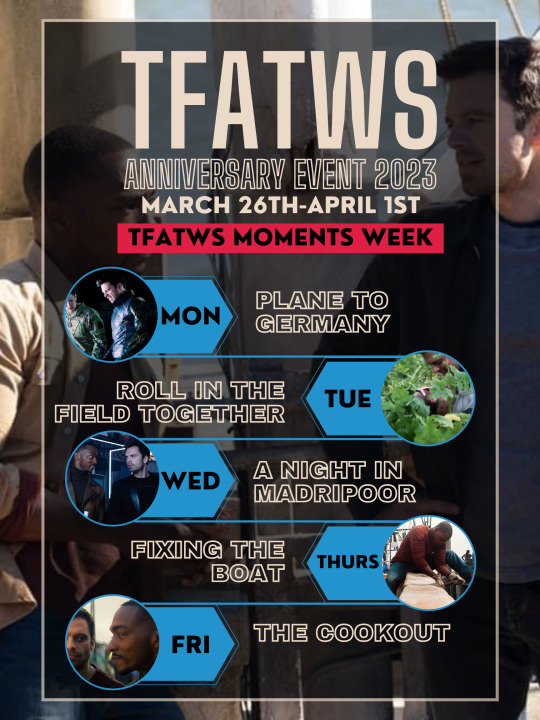
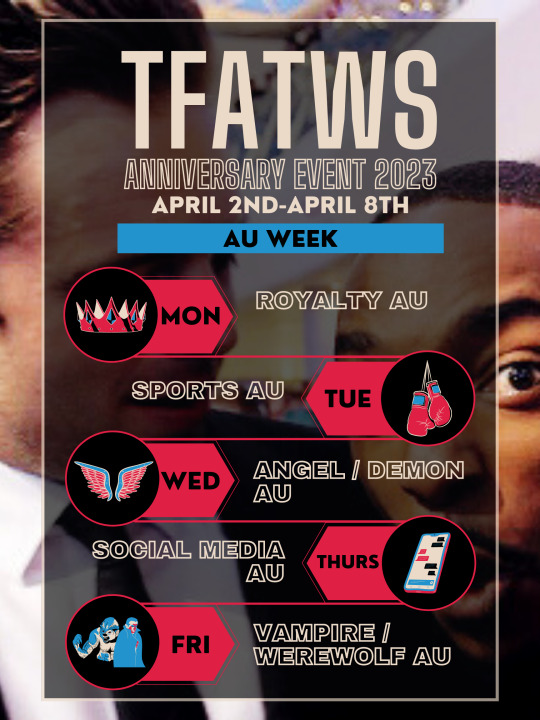


For the text version of the information above as well as the FAQ and rules, check the information under “keep reading”.
Pre-TFATWS Week: March 19th-March 25th
Monday: The Steering Wheel Incident
Tuesday: Searching for Bucky Barnes
Wednesday: On the Run Together
Thursday: In the Soul Stone
Friday: Six Months of Ghosting Sam
TFATWS Week: March 26th-April 1st
Monday: Plane to Germany
Tuesday: Rolling in the Field Together
Wednesday: A Night in Madripoor
Thursday: Fixing the Boat
Friday: The Cookout
AU Week: April 2nd - April 8th
Monday: Royalty AU
Tuesday: Sports AU
Wednesday: Angel/Demon AU
Thursday: Social Media AU
Friday: Vampire/Werewolf AU
Romance Tropes Week: April 9th - April 15th
Monday: Getting Together
Tuesday: Enemies to Lovers
Wednesday: Hurt/Comfort
Thursday: Fake Dating
Friday: First Time
SamBucky Week: April 16th - April 23th
Monday: Redwing
Tuesday: A Couple of Guys
Wednesday: I Would Be His Roommate, But
Thursday: Costco Tub of Lube
Friday: Best Friend's Best Friend
FAQ
What is this?
It’s a SamBucky event.
Is there any pressure?
No pressure at all. Fill one prompt. Fill all the prompts in a week. Do however many you please.
Can I fill more than one prompt with one piece of art/one fic?
Yes! You can fill one prompt with one piece of art or fic. You can try to fill all five prompts that week at once with one piece of art or fic. You can do any number in between.
Are there any prizes for making anything for this event?
Just the satisfaction that you made something cool.
Is it just SamBucky?
Yes please, just SamBucky. There can be side ships, but the main ship should be SamBucky.
How long will this event run?
It will run from March 19th and run until April 23th.
I heard there are badges I can use for each fill?
There are! They will be revealed on the Sunday of each week.
Rules and Guidelines
What are the guidelines for the bingo?
I will be borrowing some of this from the MYSU Valentine’s Day Bingo 2022 Guidelines, since they were fantastic.
For Everyone:
1. Remember to @sambuckylibrary in the post as well as #tfatwsanniversaryevent2023.
2. Please also tag the square you’re filling (for instance, if the square is “Sports AU”, use “#sports au” as one of your tags when posting about it on Tumblr).
3. If you’re uploading to AO3, please:
a ) Say somewhere which prompt you’re filling.
b ) Add it to TFATWS Anniversary Event 2023 Collection (TFATWS_Anniversary_Event_2023).
For Artists:
1. Create at least one piece of new art that can’t have been posted anywhere else before this.
2. All visual art forms are welcome:
a ) Gifsets, at least 3 gifs.
b ) Aesthetic boards or moodboards, at least 4 images each.
c ) Drawing/painting, that is not a sketch.
For Authors:
1. At least 500 words.
2. Posted on Tumblr or AO3.
3. Can be part of a series, but should work as a standalone.
For Podficcers:
1. The podfic should at least be 10 minutes long.
2. It should be posted on either Tumblr or AO3.
3. The podfic can be of a fic made for the event, a fic not made for the event while still adhering to the prompt, or a notfic.
Things to be mindful of when creating:
For Sam
Avoid framing Sam only as a caretaker or emotional support for Bucky. Be mindful of Sam acting angry or aggressive in an out-of-character way and falling into the angry/sassy Black man trope (check out the MCU source material to help with character traits).
Avoid decentering Sam as a main character and refrain from focusing entirely on Bucky.
In art: avoid whitewashing Sam’s skin and research drawing Black characters.
General disclaimer: Race affects every aspect of his life, including interacting with police/government and the white structures of the world when it comes to performing his duties as Cap and simply being a Black man that lives in the U.S.
For Bucky
Avoid phrasing “flesh/normal/human hand” to refer to the contrast between his prosthetic arm and his right arm. The phrasing is ableist. You can simply refer to his prosthesis when relevant, otherwise use “right/left arm/hand”.
Specific Tags:
Avoid tags in AO3 like “Sam Wilson is a Gift”, “Sam Wilson is a Saint”, and "Bucky Needs a Hug".
Have fun and we look forward to your TFATWS Anniversary fics!
- The Mods
#tfatwsanniversaryevent2023#sambucky#sam wilson#bucky barnes#tfatws#tfatws anniversary event#sambucky fanfic#sambucky art#sambucky edit#sambucky moodboard#mod: thatmexisaurusrex
169 notes
·
View notes
Text
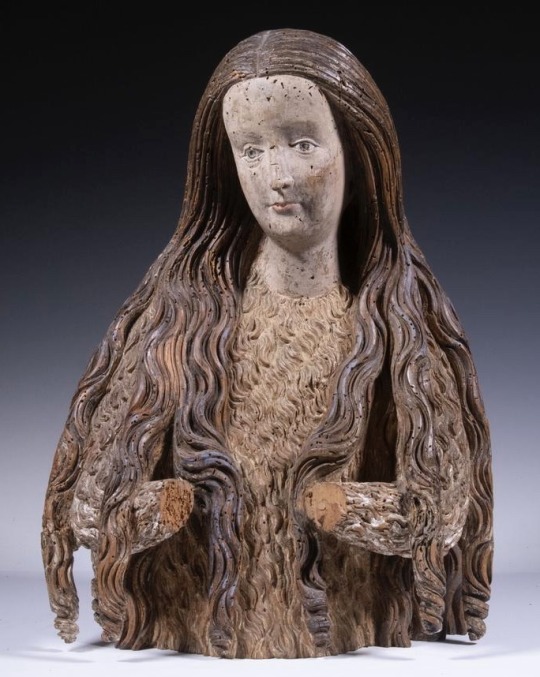
15TH C. FLEMISH/SOUTHERN GERMANY CARVED WOODEN BUST
Portrait of Mary Magdelene, depicted as a young woman with long strands of curling hair falling to her waist over the hair shirt celice she is wearing, her face having honest, open expression, her hands missing. In remnants of polychrome paint and gilding, with the reverse hollowed out.
Thomaston Place
147 notes
·
View notes
Text

The real secret behind P-51B/C/D Mustang range
The P-51 Mustang
Controlling the air proved key to controlling the ground. The long-range P-51 Mustang fighter was invaluable to the Allied victory, enabling resumption of strategic bombing after heavy losses suffered by unescorted bombers in 1943. Developed for export to Britain, models modified by the British to use Rolls-Royce Merlin engines became America’s most capable wartime fighters.
In fact, in December 1943 the first Merlin-engined P-51B/C Mustangs entered combat in Europe. These P-51s provided sorely needed long-range, high-altitude escort for the US bombing campaign against Germany.
The P-51D arrived in quantity in Europe in the spring of 1944, becoming the USAAF’s primary long range escort fighter.
Thanks to its ability to excel in long-range escort duty, the Mustang was the first single-engine plane based in Britain to penetrate Germany, first to reach Berlin and first to go with the heavy bombers over the Ploiesti oil fields in Romania.
How was the iconic Mustang able to perform such long-range escort missions? Not because of its drop tanks.
The secret behind P-51B/C/D Mustang range
‘Lots of planes could carry drop tanks: P-47, P-40, P-38, etc.,’ says James Gibson, former MP&P Engineer at Boeing, says on Quora.
‘The real secret to the Mustang’s range was not the laminar flow control wing, or the Merlin engine. It was the addition of a fuselage tank behind the cockpit halfway through production of the P-51B. This additional internal tank increased fuel capacity by 85 gallons: original P-51Bs only had 184 gallons in the wings. The addition increased total fuel to 269 gallons or some 30%. Further adding two 75 gal drop tanks you reached 419 gallons. The later D&H models carried 110 gal drop tanks for 489 gallons.
‘But when you carried so much fuel you had to be aware of which tanks you were using at which point in the flight. On take-off you used the rear fuselage tank. This tank effected the center of gravity of the plane. You didn’t want to tangle with a 109 or a Focke Wulf when carrying fuel in the rear tank. So you burned it first and then switched to the drop tanks about halfway to Berlin.’
Gibson concludes;
‘You would then burn off the drop tanks, hopefully before engaging enemy fighters. But if they struck early you could drop those tanks and thus be clean and maneuverable. This was the fight profile that allowed the Mustangs maximum range and best performance when over target.’
P-51D Mustang print

This print is available in multiple sizes from AircraftProfilePrints.com – CLICK HERE TO GET YOURS. P-51D Mustang “Dorrie R” – 44-63422 / 134, 15th FG, 78th FS “Bushmasters” – 1945
Photo credit: U.S. Air Force
Dario Leone
@TAGC17 via X
Dario Leone is an aviation, defense and military writer. He is the Founder and Editor of “The Aviation Geek Club” one of the world’s most read military aviation blogs. His writing has appeared in The National Interest and other news media. He has reported from Europe and flown Super Puma and Cougar helicopters with the Swiss Air Force.
11 notes
·
View notes
Photo
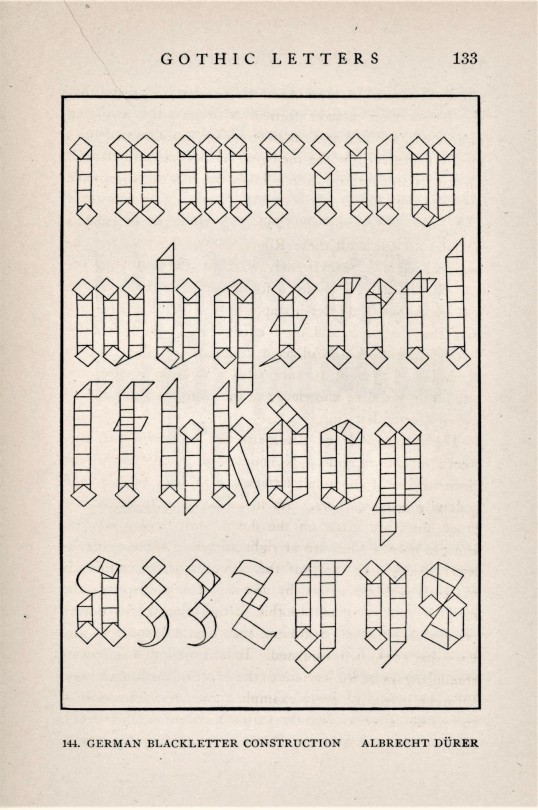

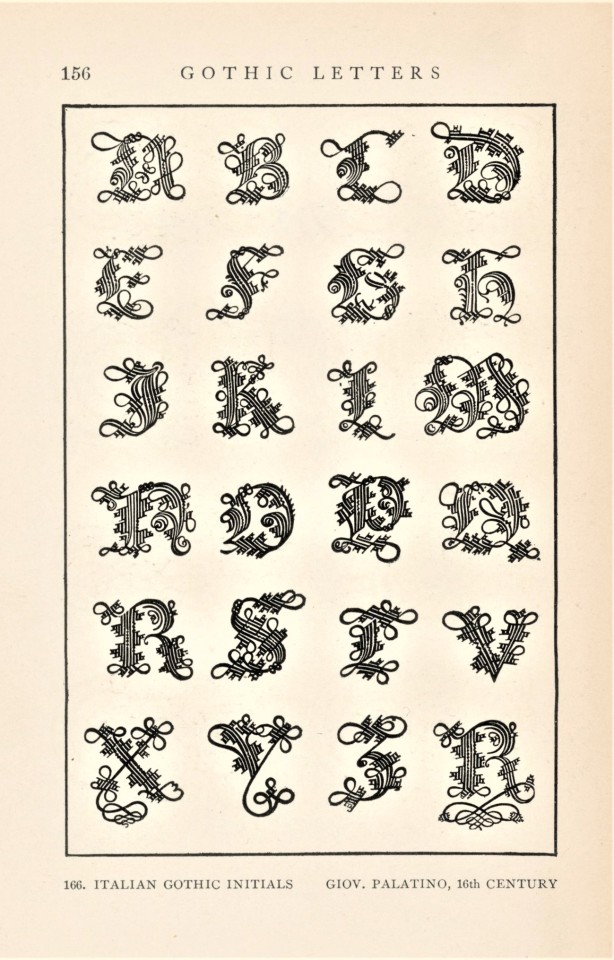
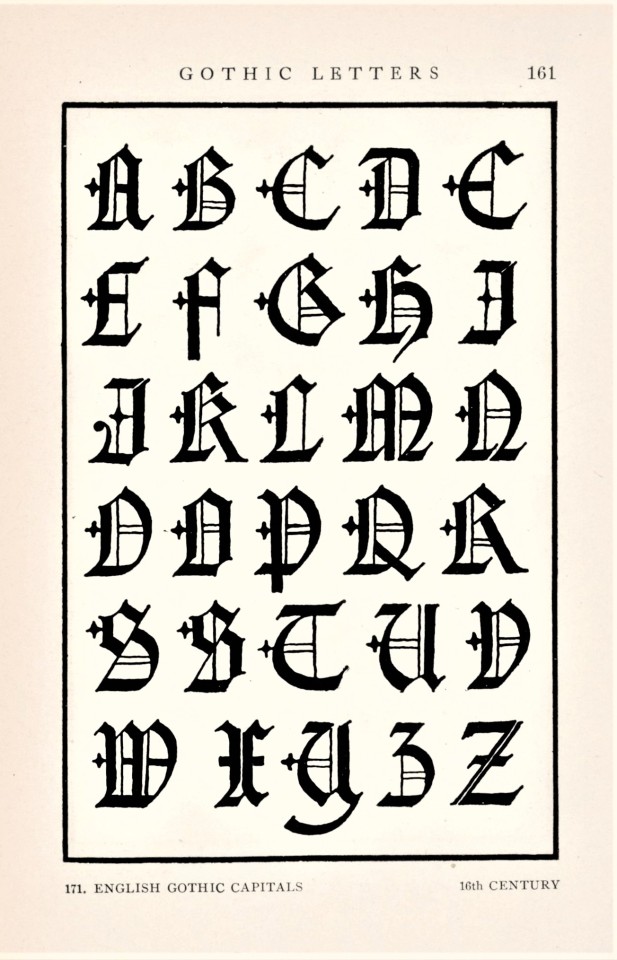


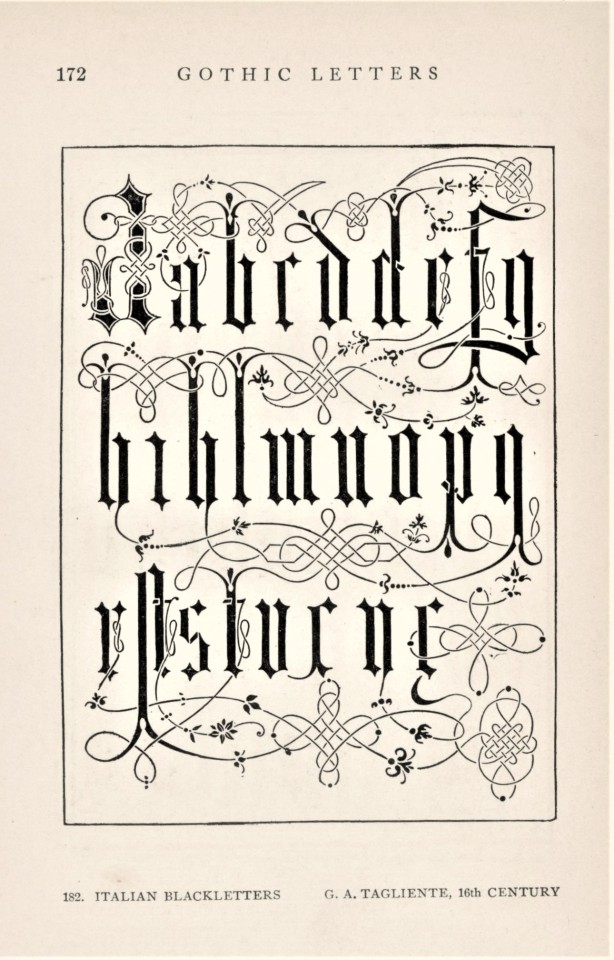
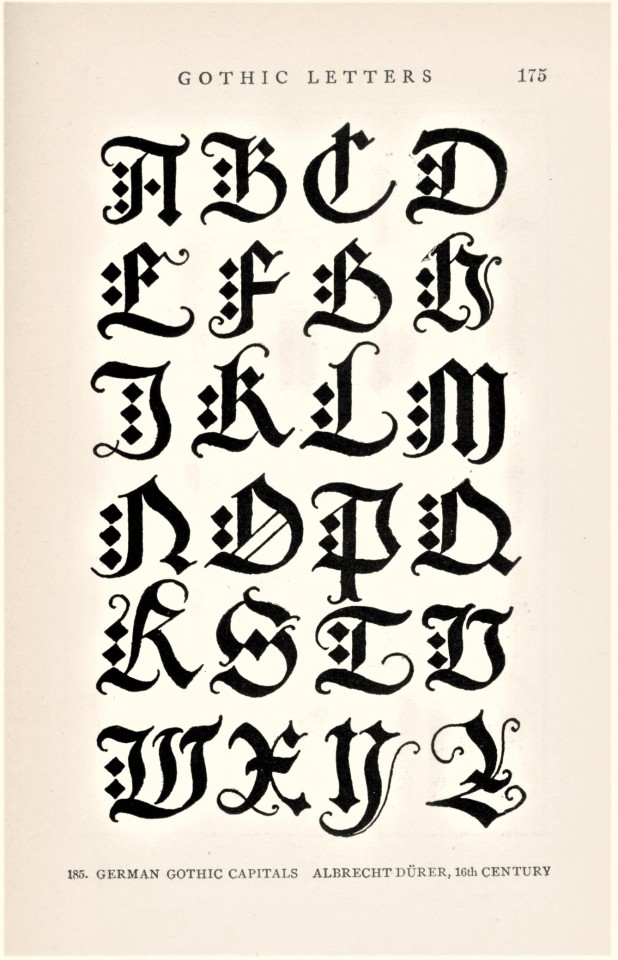

Typography Tuesday
This week we present a variety of Gothic letter forms from American architect Frank Chouteau Brown’s manual Letters & Lettering; A Treatise with 200 Examples, originally published in Boston by Bates & Guild in 1902. Our copy is a later printing published in 1914. The very first metal types were Gothic forms developed in Germany in the 15th century, and the Gothic remained the principal form to encode the German language until the early 1940s. Today, it is almost entirely used as a display face.
Shown here are designs devised by the German artist Albrecht Dürer (1471-1528), the Italian calligrapher and writing master Giovanni Antonio Tagliente (1468-1527), Italian calligrapher Giovanni Battista Palatino (c.1515 - c.1575), German calligrapher Paul Franck (fl.1600-1655), and one by Frank Chouteau Brown himself. Of the Gothic form, Brown writes:
Unlike Roman letters, which attained a complete and final development, Gothic letters never reached authoritative and definitive forms, any more than did Gothic architecture. Every individual Gothic letter has several quasi-authoritative shapes. . . . yet this very variability and variety constitute at once the peculiar beauty of Gothic and the great difficulty of so drawing it as to preserve its distinctive character.
Our copy of Letters & Lettering belonged to the English-American artist, graphic designer, and silk-screen printing pioneer Max Arthur Cohn, and was donated to us by his daughter Jane Waldbaum, professor emerita of Art History here at UWM.
View another post from Frank Chouteau Brown’s Letters & Lettering.
View more Typography Tuesday posts.
#Typography Tuesday#typetuesday#Frank Chouteau Brown#Letters & Lettering; A Treatise with 200 Examples#Albrecht Dürer#Giovanni Antonio Tagliente#Giovanni Battista Palatino#Paul Franck#Max Arthur Cohn#Jane Waldbaum#letters#lettering#type design#specimen books#specimens#20th century
222 notes
·
View notes
Text
Case Study: Lycanthropy
A.k.a. The Werewolf
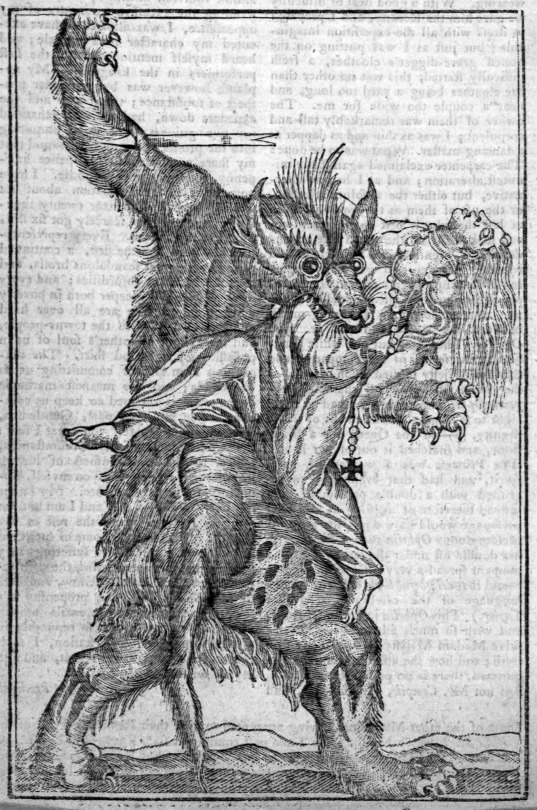
(Public Domain. 19th Century. A werewolf devouring a woman. From a XIX c. engraving. From the Mansell Collection, London.)
- - -
History:
We were made aware of the existence of werewolves in the early 15th century, when an unnamed lycanthrope was found and killed in mid-Germany. Of course, the history of lycanthropes dates far back beyond this period, as one of earliest mentions of such beasts can be found dating back to Ancient Greece, and some scholars even cite the Epic of Gilgamesh as the first literary example of a person being transformed into a wolf.
Since then, numerous theories as to the origins of lycanthropy have been posited, the most prevalent being that lycanthropy is a malicious curse created by Black Magick, a curse which is passed on from carrier to carrier via infection. Certainly, devil-worshiping witches and sorcerers have been recorded changing shape from human to animal on more than one occasion.
They remain our common enemies, In part due to their ability to create more of their kind via bite. For this reason, any infected, whether man, woman or child, are to be immediately shot and killed to prevent the spreading of their race. Remember, werewolves are the 3rd most lethal species on our record and are estimated to be responsible for up to 400 or more deaths a year. You will be doing the world a service.
Characteristics:
A lycanthrope refers to a creature who, under the full moon, will transform into a vicious beast that will hunger for the flesh of both human and animals. As time has went on, we discovered that they may also change at will, and they frequently are found to be responsible for the destruction of entire villages.
While transformed, they appear to be monstrous wolf-man hybrids with powerful jaws and razor sharp claws. They are extremely strong, with the most infamous reported to be able to lift entire tree trunks, as well as carriages and train cars. They can bite through bone, wood and it seems even metal, and are suspected to have exceptional regenerative capabilities.
A lone lycanthrope is uncommon, as most live in pairs or groups of up to 15 at a time, the greatest example of this being the infamous Bowers’ Gang. This poses a difficulty for lone hunters, and so we do not advise you to ever face a werewolf alone. Even if it appears as if they are solitary, there may be others hiding in wait.
They can live up to 200 years old, as found by our researchers after conducting a study on the so called ‘Edinburgh Dog Man,’ and it is suspected that there are numerous ancient clans
When detecting lycanthropes in human form, unusually coloured eyes (often golden or orange), elongated canines and fingernails, abnormal hair growth, as well as ‘growling or sniffing’ are the telltale signs to look out for. However, every case should be investigated first in order to avoid unnecessary civilian fatalities.
Weaknesses:
Aconitum, also known as ‘Aconite,’ ‘Monkshood,’ and ‘Wolfsbane’ has no scent that can be picked up by humans, however lycanthropes show signs of discomfort when presented with it. It has proven to be a useful method of detecting werewolves, most famously used by the monk Edward Rothschild. Of course, as all species of this plant are highly toxic to humans, handle with care.
Silver is the most reported weakness of lycanthropes and it is essential that you always have silver bullets on hand. Because their wolf pelts are so thick, guns are preferred over blades which may break easily or become unwieldy or stuck. It is unlikely you will want to be in close contact with a lycanthrope at any rate.
In their transformed state, it has been observed that their intelligence becomes lowered, particularly in younger lycanthropes. A younger werewolf seems more liable to animalistic frenzy, but older werewolves are cunning and experienced. You must exercise caution when planning out your attacks.
As always, fire and explosives such as dynamite prove to be consistently reliable and effective, as well as useful for destroying any evidence you leave behind.
Warning: The salt, mercury and wood theories have all been thoroughly debunked. Do NOT attempt to use these strategies.
Notes:
Shapeshifters taking the forms of another species are rare, but not unheard of. Bears, Foxes and Snakes are the most common outside of the standard ‘Wolf Man’ variant. However, not enough research has been conducted on these types to form a clear understanding of them yet.
We advise our good Hunters not to chase after big names such as Joshua Silver and Magnus Alfson so hastily. These names are blacklisted for a reason, and will likely require hunting parties in order to take down. However, if you believe you have encountered a blacklisted name, notify higher ups.
If you are bitten and infected in the line of duty, we salute you for your service and pray the Lord may welcome you into his Heaven upon entry. God bless you.
- - -
Date: January 28th, 1908
Signed: Virginia Hoode
22 notes
·
View notes
Text

Stollen is a fruit bread of nuts, spices, and dried or candied fruit, coated with powdered sugar or glaze and often, but not necessarily, containing marzipan. It is a traditional German Christmas bread. During the Christmas season the cake-like loaves are called Weihnachtsstollen (after "Weihnachten", the German word for Christmas) or Christstollen (after Christ).
Dresden Stollen (originally Striezel), a moist, heavy bread filled with fruit, was first mentioned in an official document in 1474. Early Stollen was different, with the ingredients being flour, oats and water. As a Christmas bread stollen was baked for the first time at the Council of Trent in 1545, and was made with flour, yeast, oil and water.
The Advent season was a time of fasting, and bakers were not allowed to use butter, only oil, and the cake was tasteless and hard. In the 15th century, in medieval Saxony (in central Germany, north of Bavaria and south of Brandenburg), the Prince Elector Ernst (1441–1486) and his brother Duke Albrecht (1443–1500) decided to remedy this by writing to the Pope in Rome. The Saxon bakers needed to use butter, as oil in Saxony was expensive, hard to come by, and had to be made from turnips.
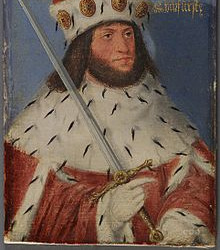
Pope Nicholas V (1397–1455), in 1450 denied the first appeal. Five popes died before finally, in 1490, Pope Innocent VIII (1432–1492) sent a letter, known as the "Butter-Letter", to the Prince. This granted the use of butter (without having to pay a fine), but only for the Prince-Elector and his family and household.Others were also permitted to use butter, but on the condition of having to pay annually 1/20 of a gold Gulden to support the building of the Freiberg Minster. The ban on butter was removed when Saxony became Protestant.
Over the centuries, the bread changed from being a simple, fairly tasteless "bread" to a sweeter bread with richer ingredients, such as marzipan, although traditional Stollen is not as sweet, light and airy as the copies made around the world. Commercially made Stollen has become a popular Christmas food in Britain in recent decades, complementing traditional dishes such as mince pies and Christmas pudding. All the major supermarkets sell their own versions, and it is often baked by home bakers.

My family’s Christmas Stollen recipe. Original recipe from the Better Homes and Gardens Holiday Cookbook, Ninth Printing (1969); p. 72
1 package active dry yeast
1/4 Cup water
1/2 Cup butter or margarine
1 Cup milk, scalded
1/4 Cup sugar
1 teaspoon ground cardamom
4 1/2-5 Cups sifted flour
1 egg
1/4 Cup chopped blanched almonds
1 Cup raisins
1/2 Cup currants (or golden raisins if currants are unavailable)
1/4 Cup candied frut
2 Tablespoon grated orange peel
1 Tablespoon grated lemon peel
Glaze:
2 C. sifted confectioner's sugar
1/4 C. hot water
1 tsp. butter, melted
1 tsp. flavoring (orange, vanilla, etc; optional)
Mix all ingredients well and glaze bread while still warm.

Soften the yeast in 1/4 C. warm water. Whisk the cardamom into the sugar. Melt the butter in the hot milk and add the sugar/cardamom and
salt (? somehow this didn't get transcribed in the ingredients list, maybe 1/4 tsp?).Cool to lukewarm. Stir in 2 C. of the flour. Add egg
and beat well. Stir in the yeast, fruits, peels, and nuts. Add enough of the remaining flour to make a soft dough.
Turn the dough out onto a lightly floured surface. Cover and let rest for 10 minutes. Knead the dough for 5-8 minutes, or until smooth
and satiny.
Place dough in a lightly greased bowl, turning once to grease the surface. Cover and let rise until doubled (about 1 1/2 hours).
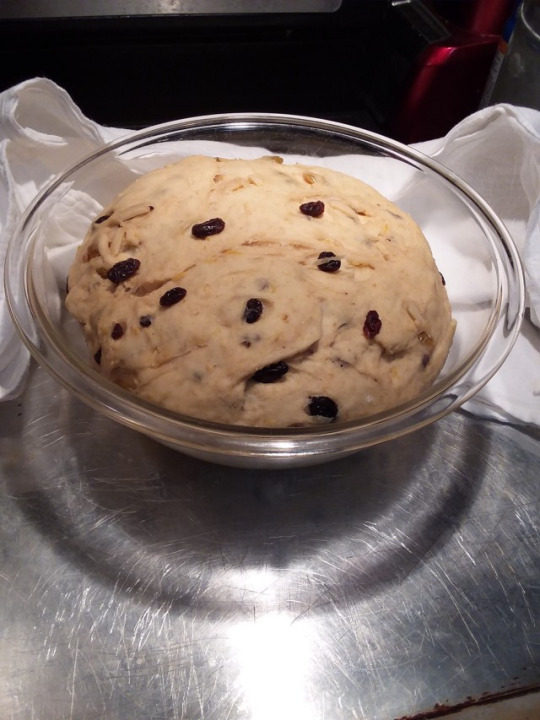
Punch down and turn out onto a lightly floured surface and divide dough into 3 equal parts. Cover and let rest for 10 minutes.
Roll dough into 12x7 inch rectangles. Fold the long side of the rectangle over to within 1 inch of the opposite side and seal the edges.
Repeat with the other two portions of dough.
Place rectangles on greased baking sheets. Cover and let rise until almost doubled (about 30-45 minutes).
Bake for 20-25 minutes at 375* or until golden brown. While still warm, brush bread with butter and dust with confectioner's sugar
or glaze.

26 notes
·
View notes
Text
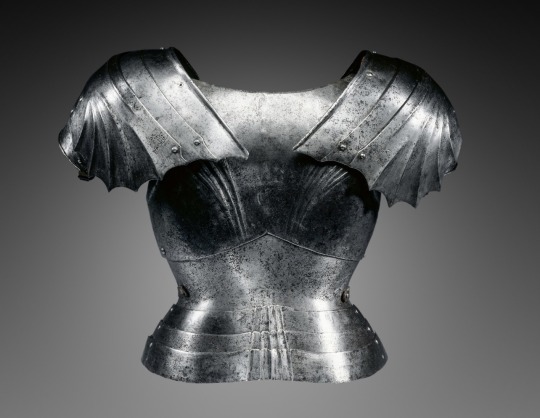
Gothic Backplate
C. 1475-1500
Germany, late 15th Century Steel, modern leather straps
5 notes
·
View notes
Text
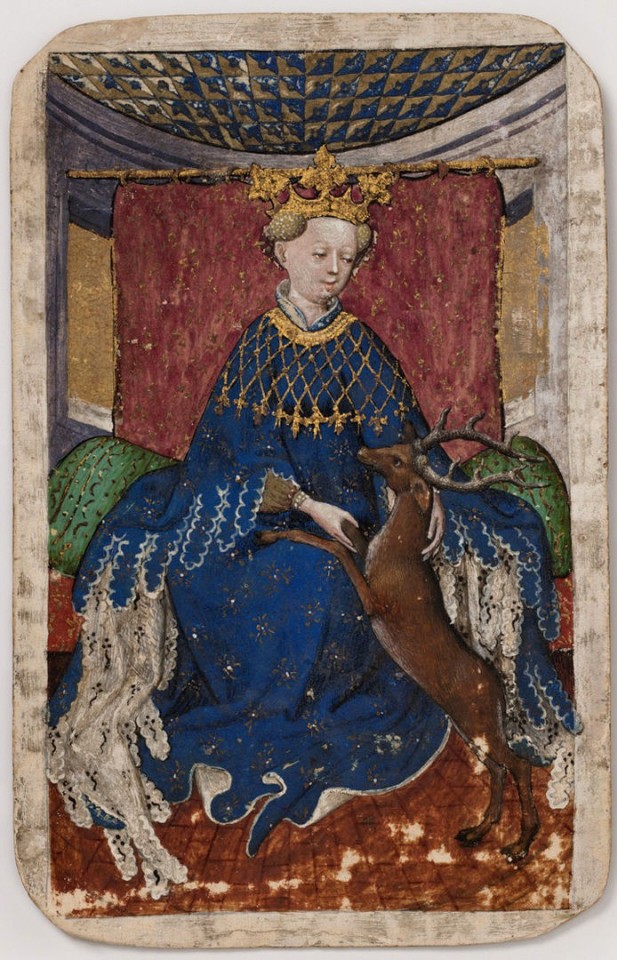


Images from 'The Stuttgart Playing Cards', c. 1430 Germany
361 notes
·
View notes
Text
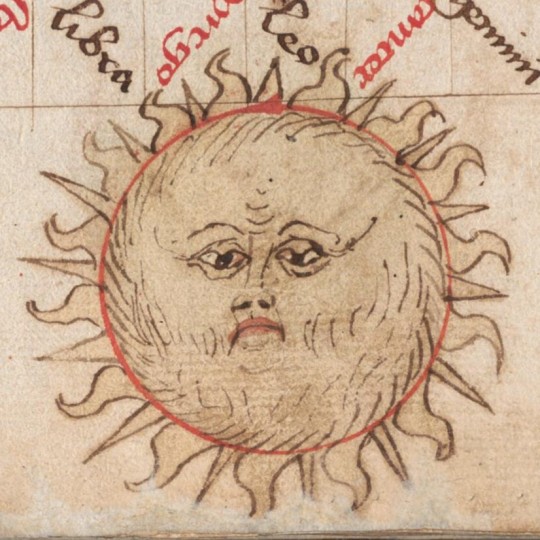

sun and moon
in an astrological miscellany ('tübinger hausbuch'), germany, mid-15th c.
source: Tübingen, Universitätsbibl., Md 2, fol. 7v and 9r
#astrology#astronomy#tübinger hausbuch#medieval art#sun#moon#15th century#medieval manuscript#occultism
401 notes
·
View notes
Text
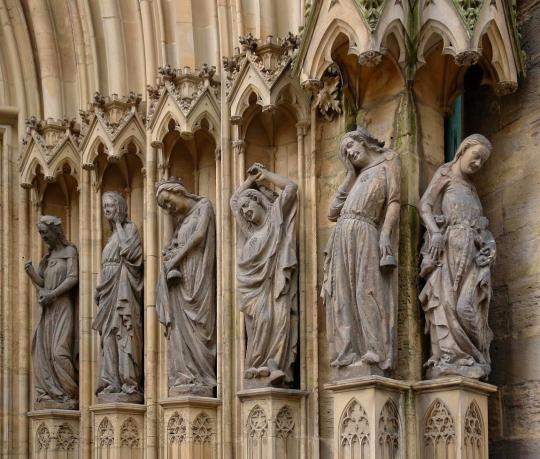
MWW Artwork of the Day (9/13/23)
Late Medieval Germany (14th-15th c.)
Detail: Parable of the Ten Virgins (15th c.)
Stone sculptures
Erfurter Dom, Erfurt (Germany)
The "Parable of the Ten Virgins," also known as the "Parable of the Wise and Foolish Virgins," was one of the most popular parables in the Middle Ages, with enormous influence on Gothic art, sculpture and the architecture of German and French cathedrals. The parable appears in only one of the Canonical gospels of the New Testament. According to the Gospel of Matthew 25:1-13, the five virgins who are prepared for the bridegroom's arrival are rewarded, while the five who are not prepared are disowned. The parable has a clear eschatological theme: be prepared for the Day of Judgment.
5 notes
·
View notes
Text

Notes about Klaus ( Sunshine's version )



Firstly I'm changing his face claim to J.amie C.ampbell B.ower to fit the book description a little more.
I'm also claiming the canon of " the old ones " which basically means, I'm ditching the whole mom and pop made me this way storyline which will make a lot of his actions worse and him more evil whic is my point. If he doesn't care about you he doesn't care about you. End of story. He kills who he wants, saves who he wants and loves who he wants. He's immortal bruh
On the same note he was never human. He is one of the original branch vampires meaning he's always been one. There's other canon lore I'm following for that which goes: they're essentially a powered human, toeing the line that stops aging at a certain point in their life. He would've stopped aging in his mid to early twenties.
Klaus was a shit father to Hope in my canon because he never really saw her as her own entity but an extention of himself. He would've been hard on her wanting her to grow up quick and be just as brutal as he is to survive. // You don't have to make this your canon but it is my canon which i'll happily plot within if you're cute.
His partners and their importance to him goes: Hayley, the mother of his child although their relationship is more physical, Kat ( @lcstinfantasy ) who is quite literally baby girl, Caroline who he can never have and Camille.
Last little tidbit ( for now ) he existed long ago before the Pyramids were built, which was c. 2500 B.C. According to him, he fought in the Trojan War and helped cause the downfall of the Roman Empire. In the late 15th century, he lived in a village in Germany, where the people thought that he was the devil himself.
5 notes
·
View notes
Text

The Griffin
c. 1480–90
Martin Schongauer
(German, c.1450-1491)
Germany, 15th century
Engraving
Cleveland Museum of Art
43 notes
·
View notes
Photo

A Bridal Couple
c. 1470
Southern Germany, 15th century
Oil on panel
12 notes
·
View notes